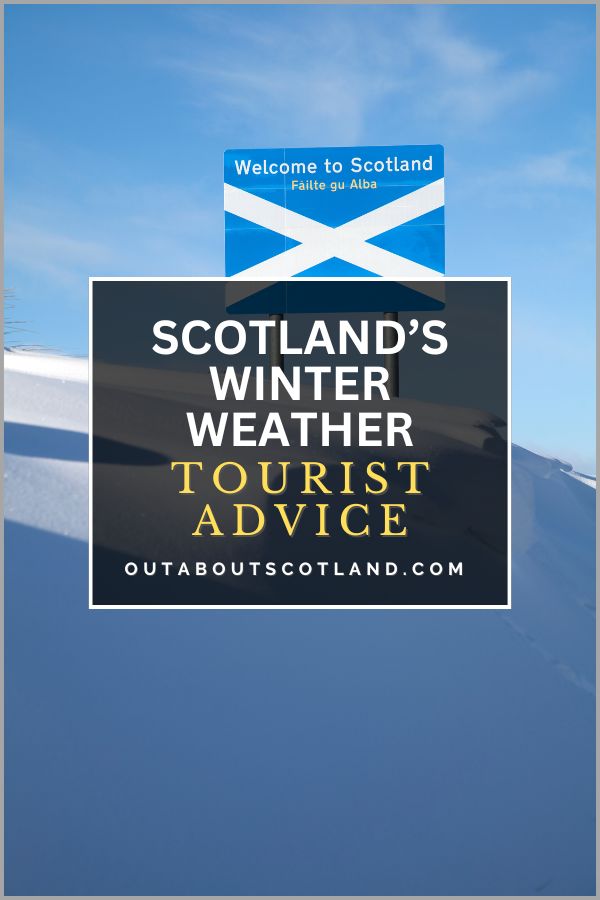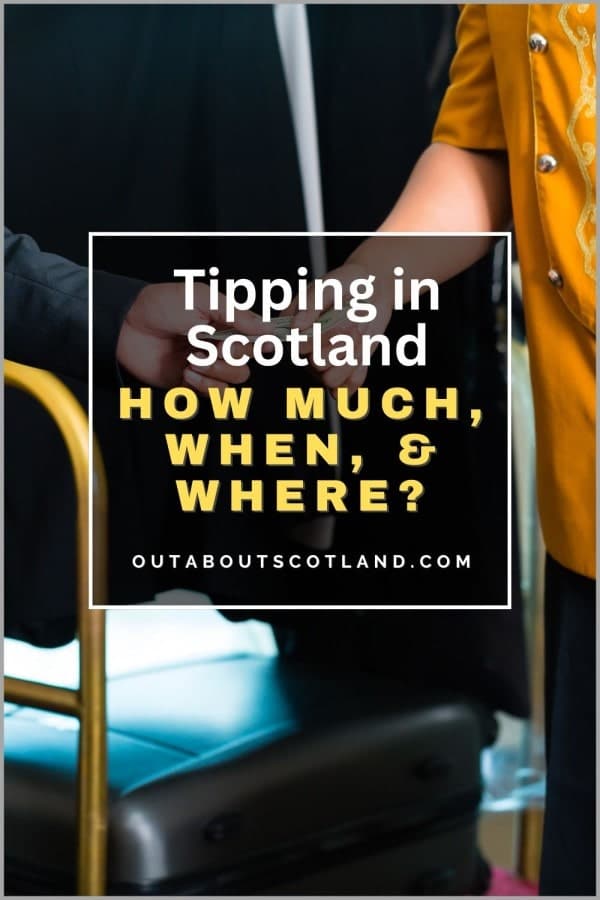It’s surprisingly easy – and cheap – to get around Scotland without a car thanks to the rail network operated by ScotRail and the inter-city bus services run by Citylink and Megabus. Alternatively, you can use Scotland’s Sustrans national cycle network or hike one of the cross-country trails on the John Muir Way, the West Highland Way, and many more long-distance off-road routes.
Discover everything you need to know about getting around Scotland without a car in this guide, which covers transport options from trains to planes, along with lots of handy money-saving tips.
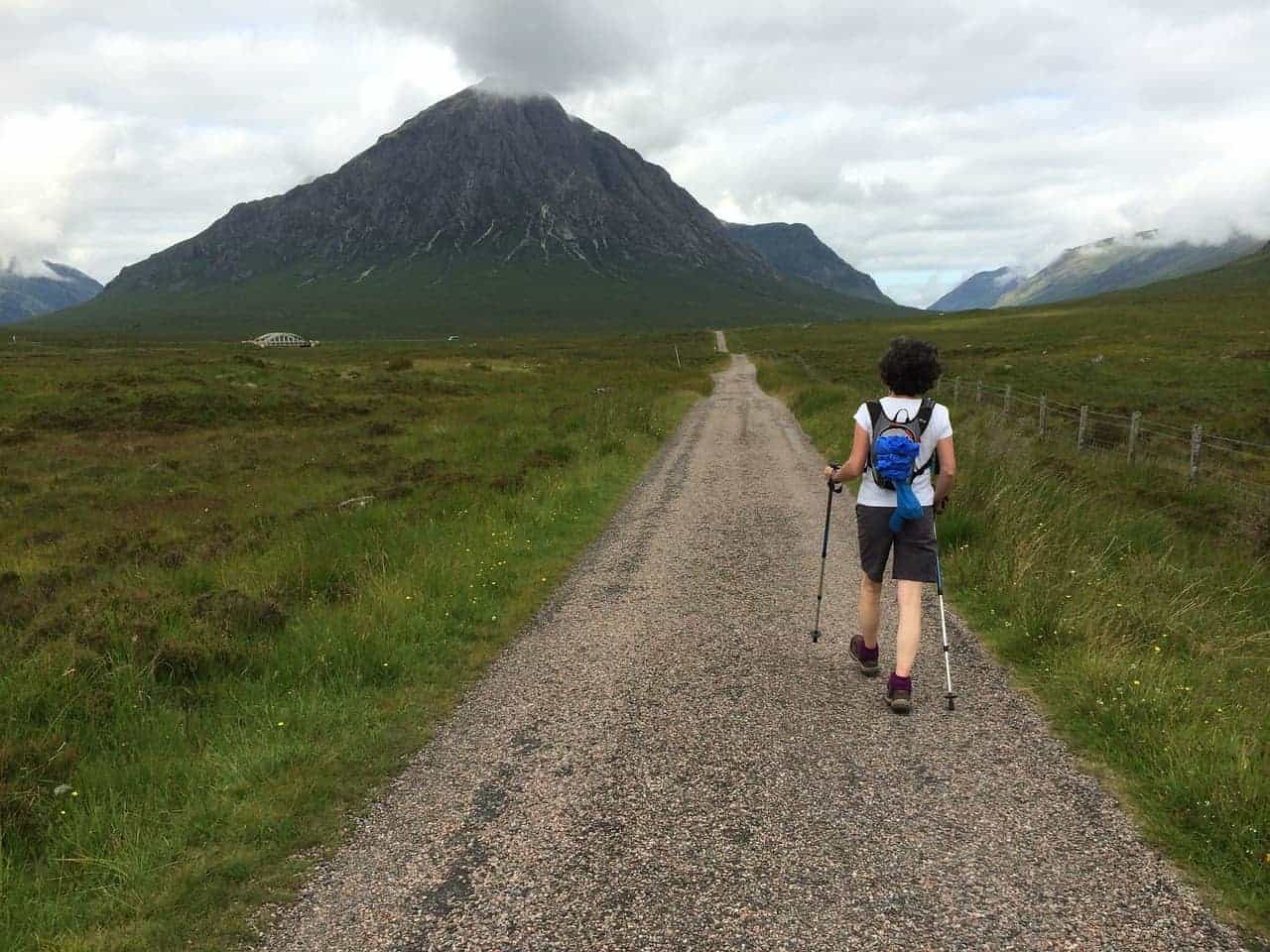
Can I Get Around Scotland Without a Car?
Quick answer – yes of course you can, as long as you’re prepared to sacrifice some comfort and are well-versed in the intricacies of Scotland’s public transport system. Long answer – It also depends on the amount of time you have and your level of personal fitness – but these are two factors that pale into insignificance against how much effort it’ll take to plan your journey.
It should be noted that there are a few instances where it’s preferable to ditch the car, such as when visiting Edinburgh or Glasgow.
Both cities have superb transport systems but getting around Edinburgh without a car is particularly easy thanks to the clean and efficient Lothian Bus network. Glasgow comes a close second with its underground SPT which is one of the oldest subways in the world, while above ground the main option is First Bus.
If you’re intent on travelling around Scotland without a car you’ll need to know exactly what other forms of transport are available, so let’s take a look at the best options in the sections below.
Protect Your Family From Scotland's Biting Midges
- Powerful, reliable protection for up to 8 hours
- Water- and sweat resistant
- Repels midges, mosquitoes, horse flies, sand flies, fleas and ticks
- Safe for use on adults, children over 30 months and pregnant women
- Non-sticky, moisturising with a pleasant fragrance
- Packaging may vary
Travel Around Scotland by Air

Scotland is well-connected to the rest of the world thanks to the super-efficient airports you’ll find in the major towns and cities. From Edinburgh in the south to Wick in the north, It’s possible to fly into Scotland from most international airports, where you can then hop on board the country’s interconnecting public transport network.
Visitors will usually arrive via Glasgow, Edinburgh or Aberdeen – each of which services the main tourist hotspots – but there are smaller airports dotted across the furthest regions if you’re looking for a quick way to get around the country.
Most people don’t use air travel as the main way to explore Scotland as it means missing out on all the stunning scenery between the airports. However, I know from first-hand experience that it certainly has its uses, such as when you’re in Glasgow with a limited amount of time but want a quick visit to the west coast islands.
If you’re interested in visiting the west coast you should know that Loganair operates from all the main airports in Scotland and is currently the only carrier to service the most far-flung destinations of the country after rival airline Flybe collapsed in early 2020.
Loganair flies to the following airports:
| Aberdeen | Inverness |
| Barra | Islay |
| Benbecula | Orkney |
| Campbeltown | Shetland |
| Dundee | Stornoway |
| Edinburgh | Tiree |
| Glasgow |
The main departure airport for Scotland’s islands is Glasgow International, and example times to get there from Edinburgh are:
- By bus – approximately 2 hours 30 minutes via Glasgow Buchanan Bus Station.
- By train – tram to Edinburgh centre, train to Glasgow Queen Street, and bus to GLA is an approximate 2-hour journey.
Total ticket costs are similar, so expect to pay around £30 for the train and £25 for the bus. For updated times and prices see Scotrail (train) and Citylink (bus).
The table below gives examples of flight times to Scotland’s remote airports from Glasgow International.
| Destination | Flight Duration |
|---|---|
| Benbecula | 1 hour 30 minutes |
| Campbeltown | 45 minutes |
| Inverness | 1 hour 35 minutes |
| Islay | 45 minutes |
| Kirkwall | 1 hour 15 minutes |
| Stornoway | 55 minutes |
| Sumburgh | 1 hour 30 minutes |
| Tiree | 1 hour 15 minutes |
Map of Airports in Scotland
| 1. Benbecula Airport | 9. Wick Airport |
| 2. Barra Airport | A. Inverness Airport |
| 3. Stornoway Airport | B. Aberdeen Airport |
| 4. Tiree Airport | C. Dundee Airport |
| 5. Islay Airport | D. Glasgow Airport |
| 6. Oban Airport | E. Edinburgh Airport |
| 7. Sumburgh Airport | F. Glasgow Prestwick Airport |
| 8. Kirkwall Airport |
Book Tours in Scotland
Facts About Scotland’s Main Airports
Edinburgh airport. Address: Edinburgh EH12 9DN. Code: EDI.
Edinburgh Airport is the third busiest in the UK due to the number of international visitors that travel through it, and as an Edinburgh resident, I can confirm the queues are hellish during the peak tourist season. On the positive side, it’s a nice place to wait and you’ll find a good selection of shops and restaurants in the main terminal as well as the usual bars and coffee shops.
If you’re just passing through, you’ll be pleased to know the transfer services are first-class, with a regular airport bus (number 100) running every 10 minutes, 24 hours a day, to Edinburgh city centre. There’s also a tram station at the airport that runs into the city – plan for around 40 minutes – and there are taxi cabs stationed at the exit.
Glasgow airport. Address: Paisley PA3 2SW. Code: GLA.
Glasgow International Airport is around an hour’s train ride from Edinburgh and serves destinations worldwide, with upwards of 120 routes as of 2023. Due to the fact it’s the main hub for people travelling overseas it’s also horrendously busy in summer, but unlike Edinburgh, it seems able to handle the queues fairly efficiently.
There are regular bus links from Glasgow city centre as well as dedicated taxi ranks at the airport entrance, but if you’d rather take the bus then the First Glasgow Airport Express service 500 will take you to the airport from Queen Street and Glasgow Central station.
Aberdeen airport. Address: Dyce, Aberdeen AB21 7DU. Code: ABZ.
Anyone who wants to head straight onto a Speyside whisky tour or get their boots on for a trek into the Highlands should make their way to Aberdeen airport as it’s within easy distance of the Cairngorms (Aberdeen to the picturesque Highland town of Braemar is just 55 miles).
I wouldn’t plan on spending too much time in the airport as it’s mostly used by businessmen and offshore workers so it has a corporate feel about it, but thankfully the connections with the rest of Scotland are excellent.
Because Aberdeen airport is a popular business stopover you’ll find lots of hotels nearby including Jurys Inn, Premier Inn and Holiday Inn which are all within a few minute’s drive from the main terminal, while bus stops and taxi ranks can be found on the road directly outside the main entrance.
If you want to head into Aberdeen, First Bus Aberdeen has a dedicated No. 727 bus running every 10 minutes to the main bus and rail stations in the city. If you’d rather take the train, the nearest railway station is about 3 miles away at Dyce, where passengers will also find a taxi rank in the station car park.
Inverness airport. Address: Dalcross, Inverness IV2 7JB. Code: INV.
You’ll find this international airport at Dalcross, which is roughly 8 miles from the centre of Inverness. Although it’s much smaller than the other airports I’ve listed it still serves nearly a million passengers annually, mainly for the links to London and the north coast island airports at Sumburgh and Kirkwall.
Inverness is known as the capital of the Scottish Highlands so flying there makes sense if you intend on heading straight into a wilderness adventure, but bear in mind it only takes 4 hours to get to Inverness by train from Edinburgh, and the scenery along the way is extraordinarily pretty.
Inverness itself is a lovely city so you might want to spend a little time exploring it rather than rushing straight off to another destination, but if you’d rather hit the open road you’ll find a taxi rank directly in front of the airport terminal building. There are also bus stops that operate every 20 minutes from the airport to Inverness city centre, Nairn, and Elgin.
Travel Around Scotland by Train
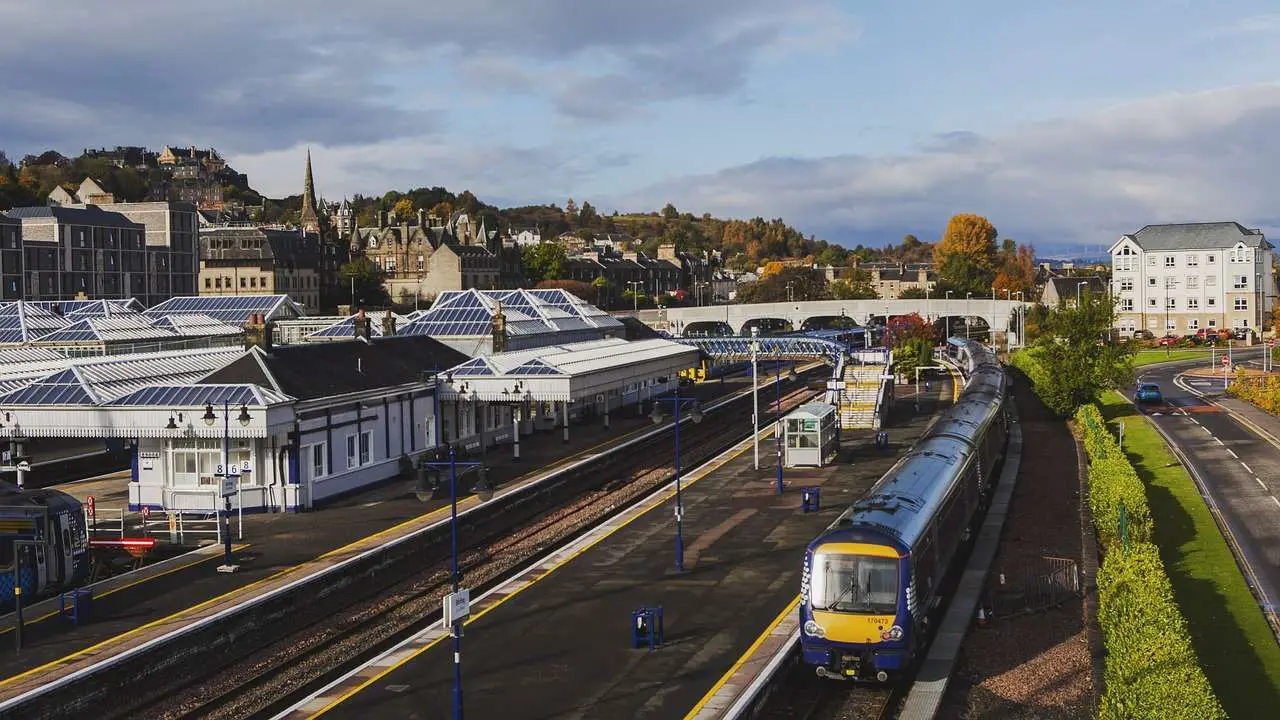
We have a bit of a love-hate thing going on with trains here in Scotland. I personally really like travelling by train as it gives you the freedom to enjoy the scenery whooshing past the window without having to worry about roadworks and traffic jams, but I’ll be the first to admit our rail network is sorely lacking in a lot of areas.
First off, while they’re clean and usually on time, they’re also ridiculously expensive for longer journeys so you’d better get a second mortgage or rob a bank (…don’t rob a bank…) if you’re intending to spend an entire holiday travelling around the country by train using first-class tickets. To give you an idea, as of 2023, it costs around £50 for a single journey from Edinburgh to Inverness and the same to travel from Glasgow to Aberdeen, and you can double that if you want to upgrade to first class.
A bus meanwhile, costs around £25 for the same journey and takes almost the same amount of time. So that’s half the cost to get to the same destination. The bus is a no-brainer, right? Well, maybe, but if you’re on holiday the extra cost kind of makes sense.
For starters, train tracks are often miles away from urban areas and motorways so on some routes you’ll get to gaze at Scotland’s unspoilt wilderness up close in a way you’d never see if you were stuck behind a smoky lorry on the A9.
The second bonus of taking the train is that they’re totally direct from start to finish (apart from station stops) so there are no long detours around accidents and they’ll never get congested as our single-lane roads do. Simply sit back, press your nose against the window, and enjoy the ride while someone else does all the work for you.
My advice for using the train to explore Scotland on a holiday is to head over to the ScotRail website and order one of their travel passes which drastically reduces the cost compared to buying lots of individual tickets. They’ll also keep you on a selection of the most scenic routes as opposed to just choosing a random destination and hoping for the best.
An example price for ScotRail’s all-in-one tickets is the Highland Rover travel pass which gives you four days of unlimited travel in the North and West Highlands over eight days for around £100 using train, ferry, and coach travel. An alternative is the Spirit of Scotland travel pass which is the same price but covers the whole of Scotland.
I’ll list a few of my favourite and recommended Scottish railway journeys below.
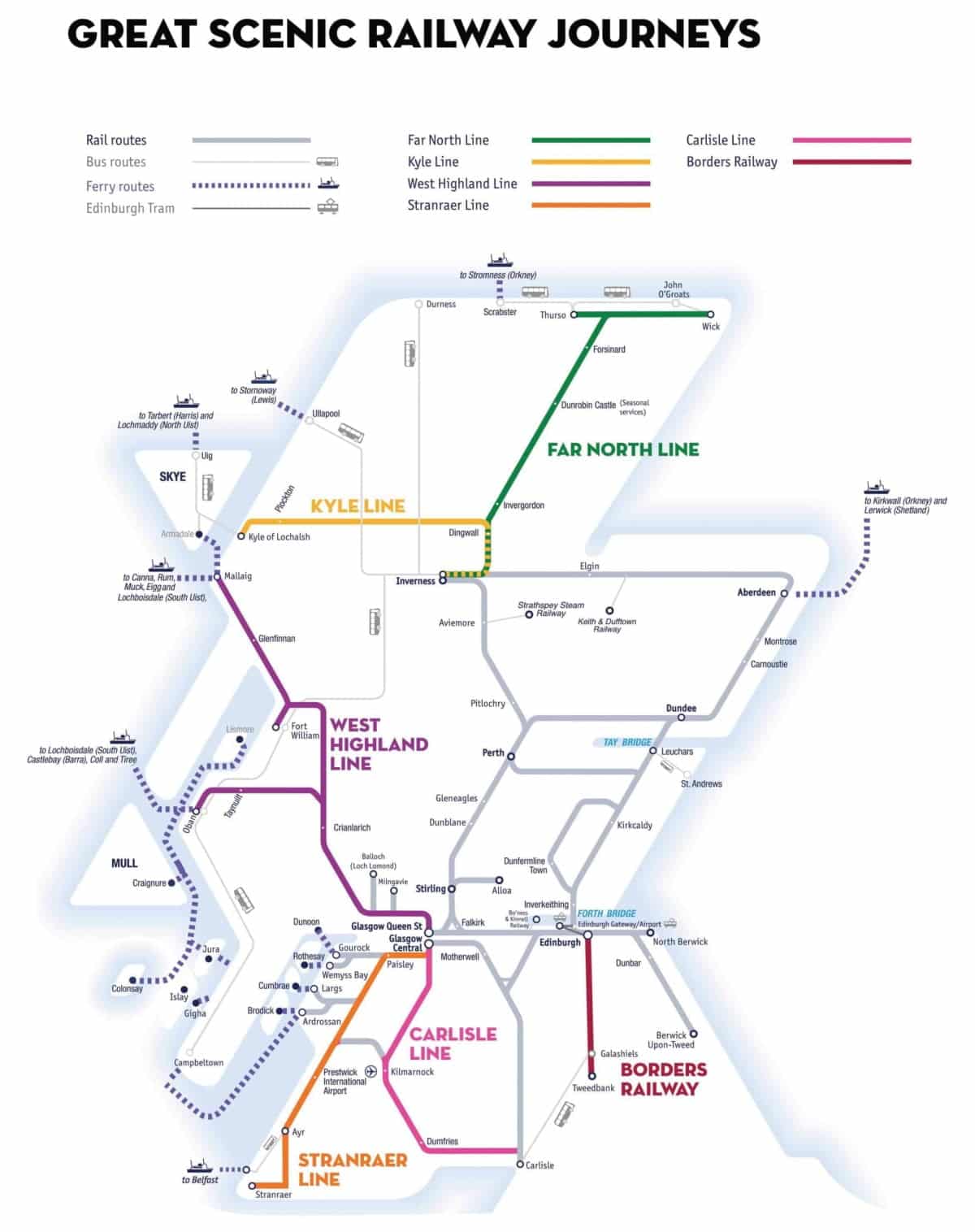
The West Highland Line.
- Journey time: 3 hours 50 minutes.
- Highlights: The Highlands gateway town of Fort William. Glenfinnan and the spectacular viaduct.
I was lucky enough to get a ticket for the Jacobite Express a few years ago which runs along the final third of the West Highland Line, so this railway holds a lot of special memories for me. Having completed the entire route from Glasgow to Mallaig I can confirm it’s jaw-dropping – especially the section at Glenfinnan – and it totally lives up to its title of being one of the most scenic rail journeys in the world.
The West Highland Line starts in Glasgow so getting to the first station at Queen Street is easy, but be warned that also means it gets busy in the peak tourist season (June to August) so you might not necessarily have the most relaxing of times. That being said, I travelled the length of it in October which was very quiet and I frequently had the carriage to myself.
If you’ve not heard of the Jacobite Express and Glenfinnan, it’s the bit in the Harry Potter movie where the Hogwarts Express goes over an enormous multi-arched viaduct. The Jacobite steam train ride from Fort William to Mallaig is privately run so you won’t be able to use a standard ScotRail ticket, but you can pre-book tickets through Get Your Guide which is one of the biggest tour ticket operators in the world.
The Far North line.
- Journey time: 4 hours 30 minutes.
- Highlights: Wick. Dunrobin Castle.
This railway operates between Inverness which is just north of the tip of Loch Ness to Wick which is just a few miles south of the northernmost point of Scotland at John O Groats. I travelled this route about a year ago and I have to say I enjoyed it, although it isn’t as scenic as the West Highland Line. Still, it’s attractive in its own way and it’s the best way to see this less-visited part of Scotland.
The stations in between the start and endpoints are a bit uninspiring (Invergordon and Forsinard aren’t much to write about) but it does at least stop at Dunrobin, so you can get out and visit the stunning Dunrobin Castle.
The final station at Wick is a bit grey, to be honest, but the coastline further north is spectacular and worth the journey alone, especially at the UK’s most northeast point at the Duncansby Stacks.
The Kyle Line.
- Journey time: 2 hours 40 minutes.
- Highlights: The Torridon Peaks, Achnashellach Forest, Ben Wyvis.
Whereas the Far North and West Highland lines stretch north to south, the Kyle line runs between them from east to west. This is a fantastic railway that easily rivals the tourist-favourite route between Fort William and Mallaig and you’ll see a gorgeous landscape of mountains and lochs from Kyle of Lochalsh to Inverness.
A recommended option is to complete the West Highland Line from Glasgow and continue on the Kyle Line to Inverness. It’s a bit of a trek between the end of the West Highland Line and the start of the Kyle Line as you have to go inland to Spean Crescent by rail before doubling back on yourself by road on the A87, but it’s a stunning journey.
Alternatively, you can take a ferry from Mallaig to Armadale on the Isle of Skye and then take the No. 52 and the No. 50 buses across the Skye bridge to Kyle of Lochalsh which takes around three hours. The only downside to this route is that Skye is so beautiful you won’t want to leave.
Protect Your Family From Scotland's Biting Midges
- Powerful, reliable protection for up to 8 hours
- Water- and sweat resistant
- Repels midges, mosquitoes, horse flies, sand flies, fleas and ticks
- Safe for use on adults, children over 30 months and pregnant women
- Non-sticky, moisturising with a pleasant fragrance
- Packaging may vary
Travel Around Scotland by Bus

Other than cycling and walking, taking the bus is the cheapest form of transport in Scotland. You can quite easily hop on a Megabus in Edinburgh city centre and be in Aberdeen four hours later for just £20, depending on the time of day. That’s less than you’ll pay in petrol to drive the same distance in most cars.
The biggest negatives for taking the bus are the same as taking the car – traffic jams, road works, and winter road closures – but at least you can sit back in a big comfy seat while the driver deals with the tricky job of navigating Scotland’s twisty-turny roads.
If you’re thinking of using buses for long distances you’ll be well covered as the two biggest operators – Megabus and Citylink – operate from all the main cities as well as some of the smaller towns. In addition, both companies offer shuttle services between the centres of Glasgow and Edinburgh every 15 minutes.
It costs about £8 to travel between the two cities with the journey taking just over an hour, so it’s certainly worth considering if you want to explore the south of the country, but what about the north?
Well, to be honest, you’re in quite a good place if you choose to take the bus as you can easily get to Aviemore, Inverness, Aberdeen, Fort William, Perth, Pitlochry and Stirling, with each destination offering a bucket load of attractions for any visiting tourist.
Take a look at the table below for a guide to bus travel times from Edinburgh.
| Aberdeen | 3 hours |
| Aviemore | 3 hours 30 minutes |
| Fort William | 4 hours 30 minutes |
| Inverness | 4 hours |
| Perth | 1 hour 30 minutes |
| Pitlochry | 2 hours 20 minutes |
| Stirling | 1 hour 30 minutes |
Pre-book bus tickets for a tour of Scotland directly from the Megabus website.
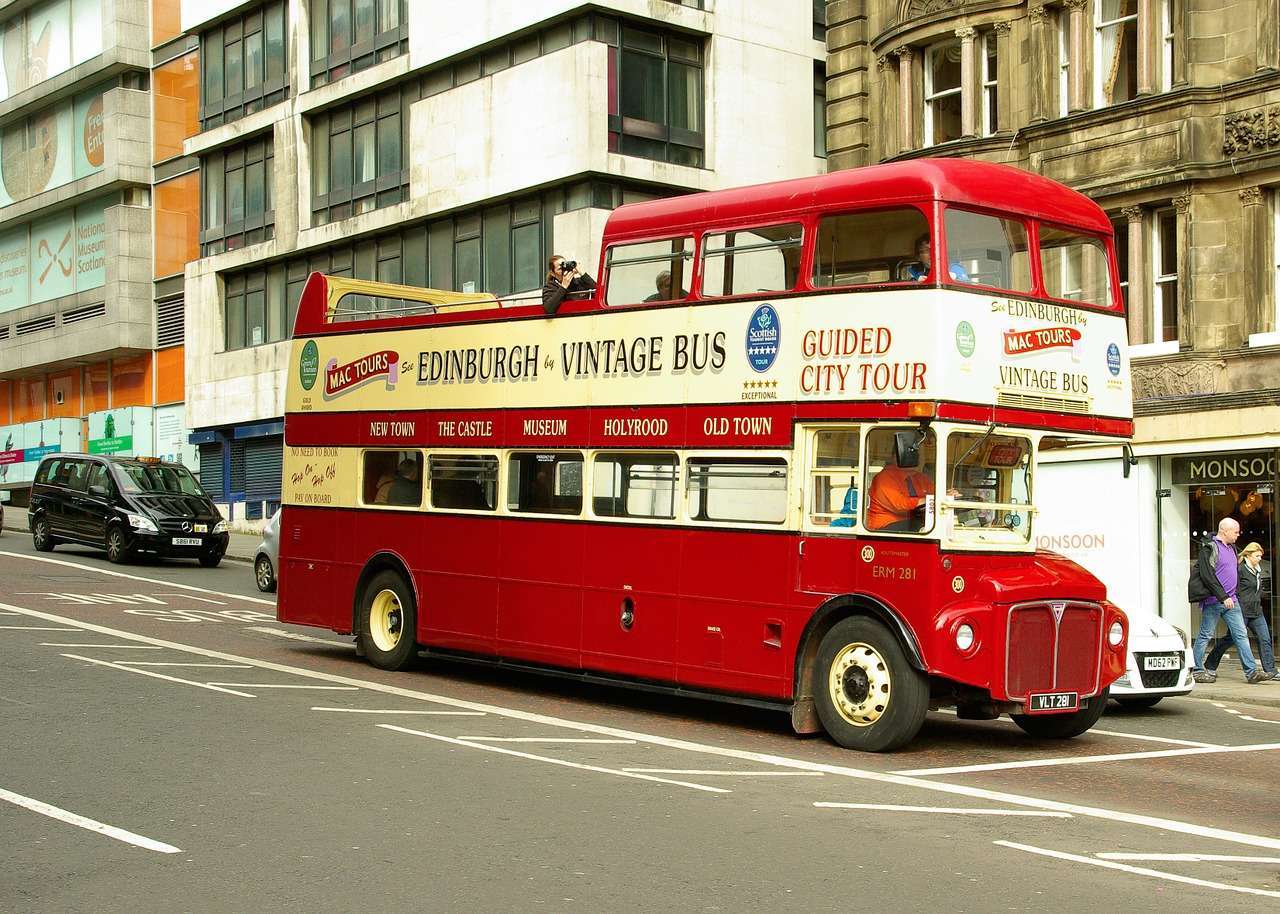
As far as fares go they’re already rock-bottom, but I’ve got a couple of tips that might help you save a little extra cash when booking your ticket.
1: Always book online and compare operators as you’ll often find competing discounts on their websites. An example of this is Megabus which currently has Edinburgh to Aberdeen on a standard ticket at £27 compared to the same journey on Citylink Gold (luxury coach, leather seats, complimentary snacks) for just £23. Same journey but very different experiences.
2: Book well in advance. The prices of tickets slowly creep up the nearer you get to the travel date so you’ll often save a packet by purchasing a few weeks beforehand.
3: On the other hand, if you book at the last minute you might be lucky and get a bargain seat if you take a chance and leave it till the hour before departure. Bus operators will often drastically reduce the price of unsold tickets in a last-ditch attempt to fill empty seats. In my experience, this tactic never works in summer when there are lots of tourists. Winter is a different story though.
4: Megabus is renowned for its special offers, so regularly check their website if you’ve got a destination in mind. Edinburgh to Inverness for a quid? Yes, please. Check out Megabus here.
Once you’re in the big cities, especially Edinburgh and Glasgow, you really don’t need any other form of transport, as the bus networks are so good. Edinburgh, in particular, has an incredible bus service operated by Lothian Buses which is almost always on time and has frequent buses that are spotless. I’ve been a lifelong worldwide traveller, and I can say hand in hand that Edinburgh’s bus and tram network rivals any other city worldwide.
Lothian Buses also have a great ticket system and you can either purchase books of tickets online or in the city centre travel shop, or you can use contactless payments with your bank card on the bus which means you never have to fumble about looking for change.
Visit the Transport For Edinburgh website for more information on Edinburgh’s trams and buses or download the Transport for Edinburgh App. To help you find your way around the bus network more quickly you can get real-time information on the web and on your smartphone.
- On computer: My Bus Tracker
- On mobile: My Bus Tracker
Glasgow is a slightly different story as the service is run by First Bus and I’ve always found their buses to be a wee bit grubby – although at least they’re cheap and there are lots of them. With that in mind, if you’d like to explore Glasgow by bus your best option is to book a hop-on hop-off bus ticket which will allow you to visit all of the main attractions on a tour bus that runs around the city in a loop all day long.
See below to book your tickets.
Once you’re away from the city you’ll find Scotland’s buses revert to something similar to the transport system they had in medieval times, which is to say it’s virtually non-existent.
Because the Highlands and the far north are so lightly populated, it doesn’t make much sense for bus companies to run extensive services, so you’ll frequently find villages with only one or two buses per day. That makes it almost impossible to tour the Highlands by bus, as you’ll have to plan your journey between stops to perfection or risk waiting 12 hours for the next one to come along.
And even worse, fewer buses mean fewer bus stops, so don’t be surprised to find the nearest stop miles away from whatever wee village you want to spend the night in.
One option I have for you if you want to explore Scotland by bus is to book yourself onto one of the excellent Rabbies small group coach tours which head out to pretty much every single corner of Scotland. I’ve only ever heard good things about Rabbies as not only are the drivers expert guides full of local knowledge but they only use small coaches so you’re never stuck in the middle of a massive crowd of strangers.
If you’d like to take a look at the tours Rabbies have to offer check out this link.
Aside from Rabbie’s coaches, my advice for using buses to explore the wilds of Scotland is don’t bother, but that’s ok because you can take my two favourite forms of transport instead – bicycle and feet.
Travel Around Scotland by Bicycle
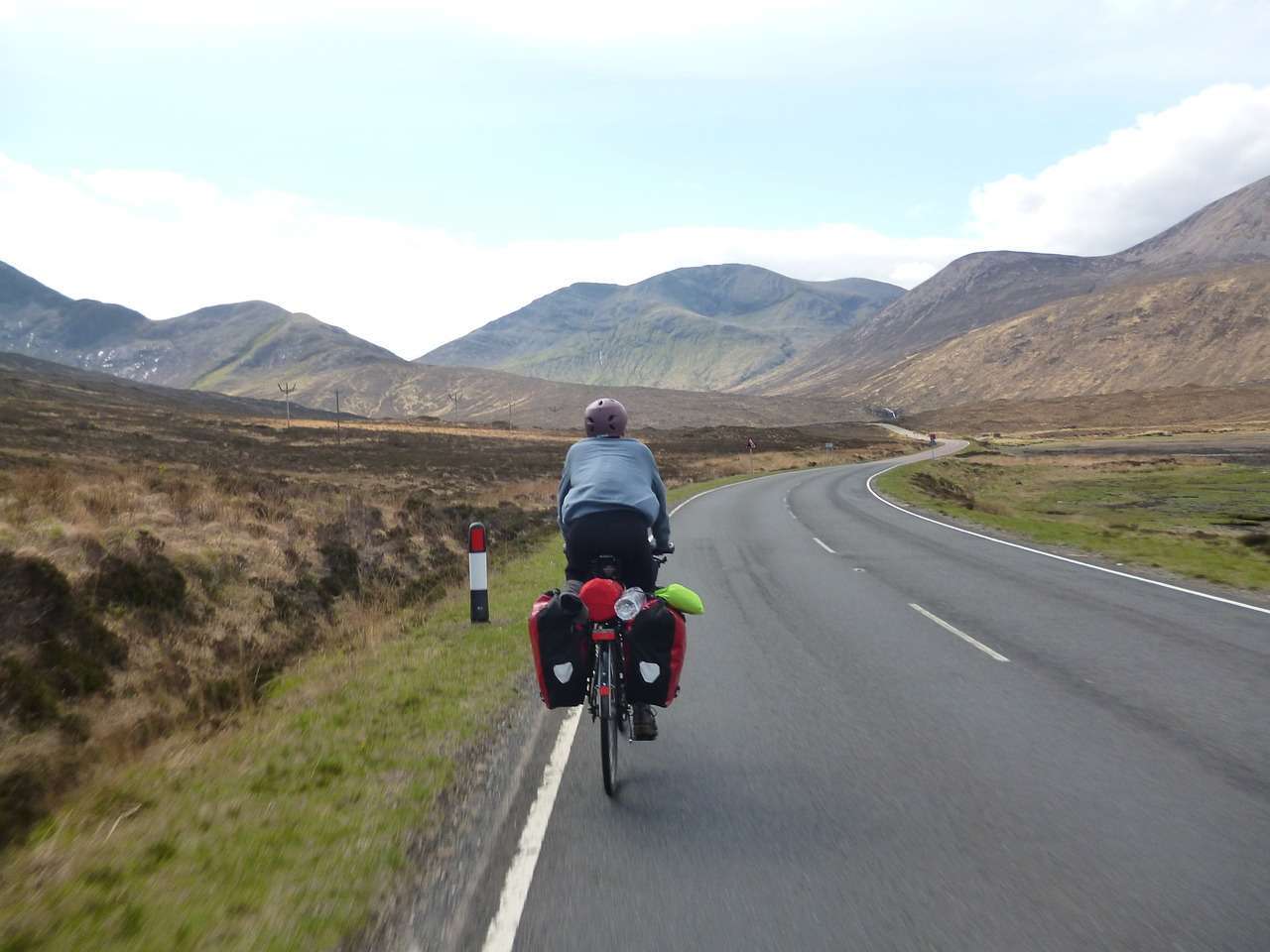
Spending just one week in Scotland without a car can be a frustrating experience – unless you happen to be travelling by bike. One of the great things about Scotland is the vast cycle network which threads its way like a spider’s web across every part of the country.
There are 2,371 miles of National Cycle Network routes in Scotland and almost a third of them (644 miles) use traffic-free paths that comprise a mix of disused railway lines, canal towpaths, forest roads, and segregated cycle lanes.
Although I’m a firm believer that walking is the best way to immerse yourself in the landscape I have to say cycling comes to a very close second place, with the bonus that you can clock up many more miles on two wheels than you can on two feet. On a sunny day there’s surely no better way to experience Scotland’s iconic castles, shimmering lochs and peaceful forests than by sitting on a bike.
The custodians of Scotland’s National Cycle Network is the charity Sustrans and they’ve gone to remarkable lengths to ensure you can enjoy a long-distance ride in safety. They’ve also mapped Scotland’s cycle routes in conjunction with OS maps, so before jumping in the saddle I recommend checking out the OS maps website to get an idea of where you can go.
Many of the Sustrans cycle routes connect the major cities so it’s perfectly possible to spend a completely car-free holiday in Scotland as long as you have your trusty bike with you.
If you’re into wild camping you’ll have the best of both worlds as you can combine a venture into the great outdoors with the occasional trip into the urban areas and if you’re thinking of island hopping you’ll have an absolute blast on two wheels.

Most of the cycle paths in the country are wide and pothole-free so you can cycle for miles in relative comfort, and coupled with the fact you’ll be keeping healthy and travelling for no cost (unless you’ve hired your bike), a cycling holiday is definitely one that should be considered if you want to explore Scotland without a car.
Although it’s easy to use the Sustrans cycle network in Scotland there are a few tips I’ll give you before exploring the best routes. You’ll need to take note of them if you’re an international visitor who isn’t used to Scotland’s roads.
1: Each cycle route is numbered and you can work out which route to take by examining the Sustrans OS website and then keeping an eye open for the roadside signage.
These signs are blue with an arrow pointing in the direction of the route along with an icon of a bike and/or a person walking (indicating the route is suitable for bikes and/or walkers). The signs also have a red box with a white number which relates to the number of the cycle route.
2: If the red boxed number is in brackets, it means you’re heading towards the route. If the number has no brackets, it means you’re on the route.
3: Some signs also have the name of the route in white lettering inside a brown box.
4: Cycle paths that are joint walking/cycling are usually split in half, with icons and separating lines indicating which side of the path to cycle or walk on.
5: If you’re cycling at night, be aware that working front and rear lights are mandatory in Scotland and you must have a bell on the handlebars to warn pedestrians of your approach.
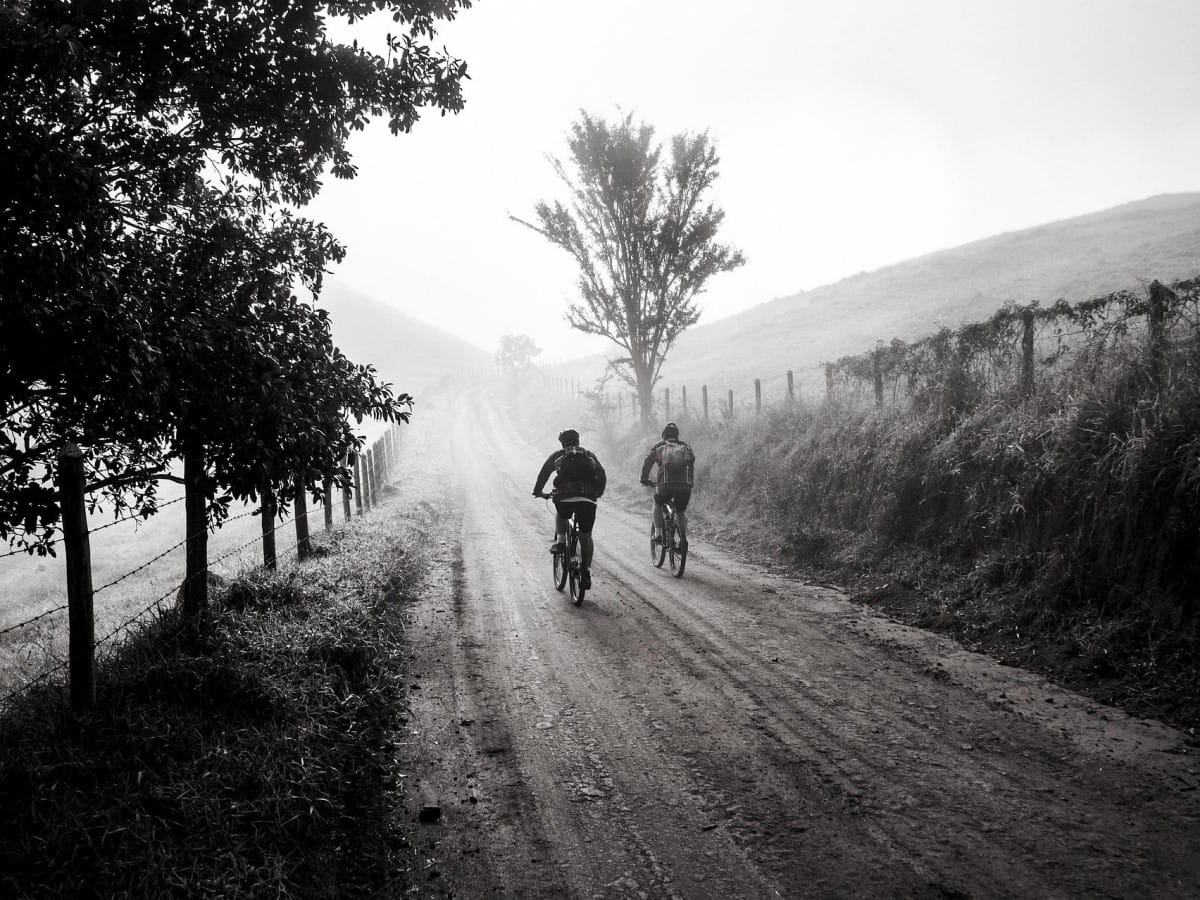
6: Because large parts of the cycle network run into the furthest reaches of Scotland, you must ensure you have a map so you don’t deviate from the designated route. I have OS maps loaded onto my phone and always take a rechargeable power pack (Amazon link) with me. You can order Ordnance Survey maps online here.
7: Another necessity is to make sure you pack a puncture repair kit, spare inner tubes, a hand pump, basic tools like Allen keys and an adjustable spanner, and additional clothing and a lightweight tent in case you unintentionally get stuck outdoors in the middle of nowhere.
Here’s an Amazon link to the all-in-one bike repair kit that I bought last year.
8: Following on from the above, pack plenty of food and water as well. Some stretches of the Sustrans cycle network are miles from any towns and villages so you can quite easily find yourself without any facilities for hours at a time.
Now we’ve got the necessities out of the way, let’s take a look at some of the amazing cycle routes we have in Scotland.
Caledonia Way. 234 miles (377km) from Campbeltown to Inverness. Cycle path No. 78.
The Caledonia Way runs from Campbeltown on the west coast to Inverness across a variety of terrains. This cycle route is a favourite with British cyclists as it showcases the best of Scotland’s dramatic Highland scenery with a series of incredible views of west coast islands and dramatic coastlines.
Beginning at Campbeltown, you follow the Kintyre Peninsula and the Great Glen Way where you’ll pass two of Scotland’s greatest natural wonders at Loch Ness and Ben Nevis.
The only downside (depending on how off-grid you want to get) is that the 120-mile section between Campbeltown and Oban is on roads, though it does change to a traffic-free path once you pass Oban and get on the section that leads to Fort William. Expect the entire 234-mile route to take 20 hours on a bike.
Hebridean Way. 184 miles (296km) from Vatersay to the Butt of Lewis. Cycle path No. 780.
If you want to escape the mainland and explore the west coast islands there’s no better place to take your bike than the Hebridean Way which winds through the spectacular wilderness of the Outer Hebrides.
Starting at the remote island of Vatersay you’ll island-hop by ferry towards Harris and Lewis with the final destination 15 hours away at the Butt of Lewis. This is one of the wildest, most windswept and utterly captivating regions of Scotland, and it’s the perfect antidote to the hustle and bustle of modern city life.
Because the Outer Hebrides are so lightly populated you’ll need to ensure you take plenty of provisions with you and have a backup plan in case you get lost as mobile phone coverage is sketchy at best. Even so, the views are utterly spectacular and the Isle of Harris has some of the most beautiful beaches you’re ever likely to see.
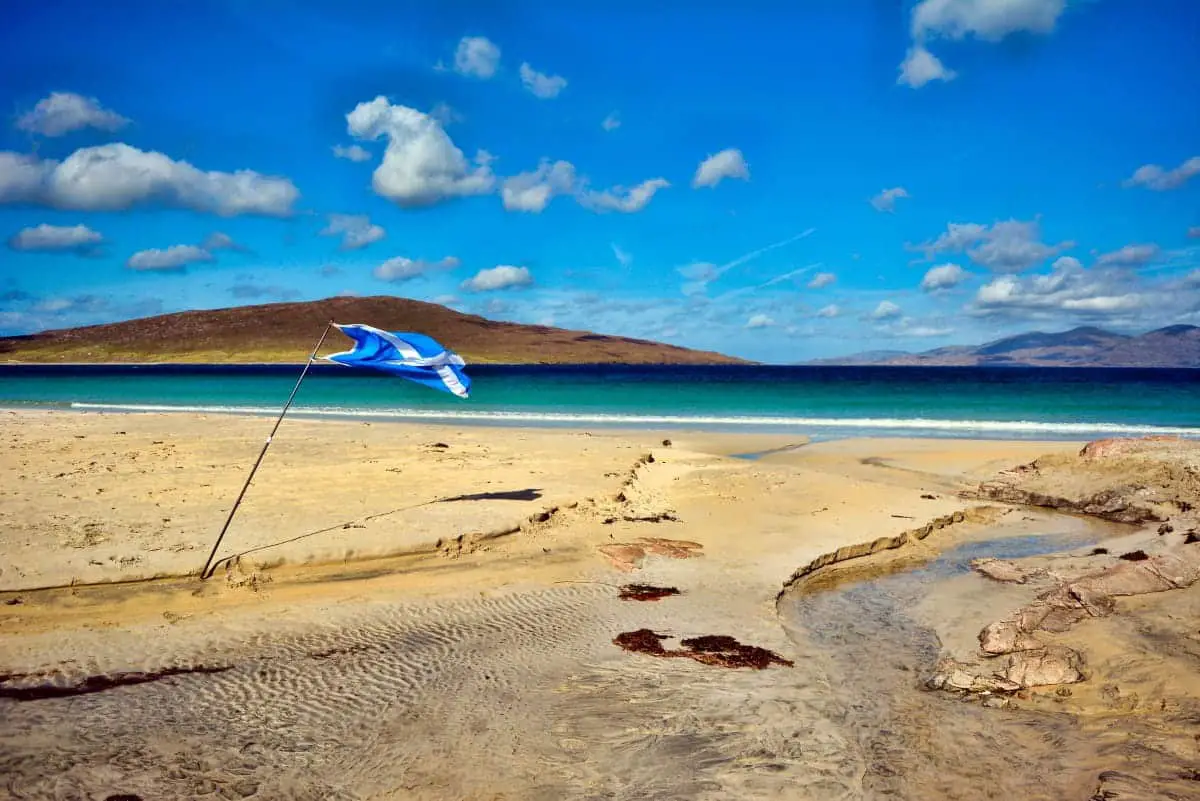
Coast & Castles North. 172 miles (276km) from Edinburgh to Aberdeen. Cycle path No. 1.
Aberdeenshire is known as the ‘castle county‘ so it’s not surprising that Sustrans created a cycle route that showcases a few of the most impressive fortresses in Scotland.
This route starts in historic Edinburgh before taking cyclists on a long-distance adventure across Fife and up the north coast towards the ‘granite city’ of Aberdeen. The coastline along the way is amazing and you seem to stumble across castles every few miles, but I have to say the best (in my humble opinion) is Dunnottar Castle which lies about 18 miles south of Aberdeen on a rocky outcrop that overlooks the North Sea.
It’s a real spectacle but there are lots of other highlights on this journey like the famous Forth Rail Bridge and the gorgeous countryside between Dunfermline and Dundee. Plan on taking 14 hours of uninterrupted cycling to complete this cycle route.
Edinburgh to Glasgow. 57 miles (92km) from Edinburgh to Glasgow. Cycle path No. 75.
As I’m lucky enough to live in Edinburgh this cycle route is right on my doorstep and I’ve lost count of how many times I’ve been on it, which is why I’m recommending it along with the more remote cycle trails above.
You might think that travelling between Scotland’s two biggest cities would mean you’d be stuck on boring urban roads, but you couldn’t be further from the truth as this route crosses an extraordinarily attractive region of Scotland where cyclists will enjoy picturesque meadows, gentle canals, and peaceful woodlands.
Starting in Edinburgh, the route passes Livingston (great shopping mall), Bathgate, Coatbridge, and Uddingston before veering towards the River Clyde and the final destination at Glasgow city centre.
So not only do you get to admire the sights of the two great cities but you get to enjoy central Scotland’s picturesque landscape as well. You’ll even pass two nature reserves – Bogburn Flood Lagoons Nature Reserve and Blawthorn Moss National Nature Reserve. The entire route should take around ten hours to complete on a bike.
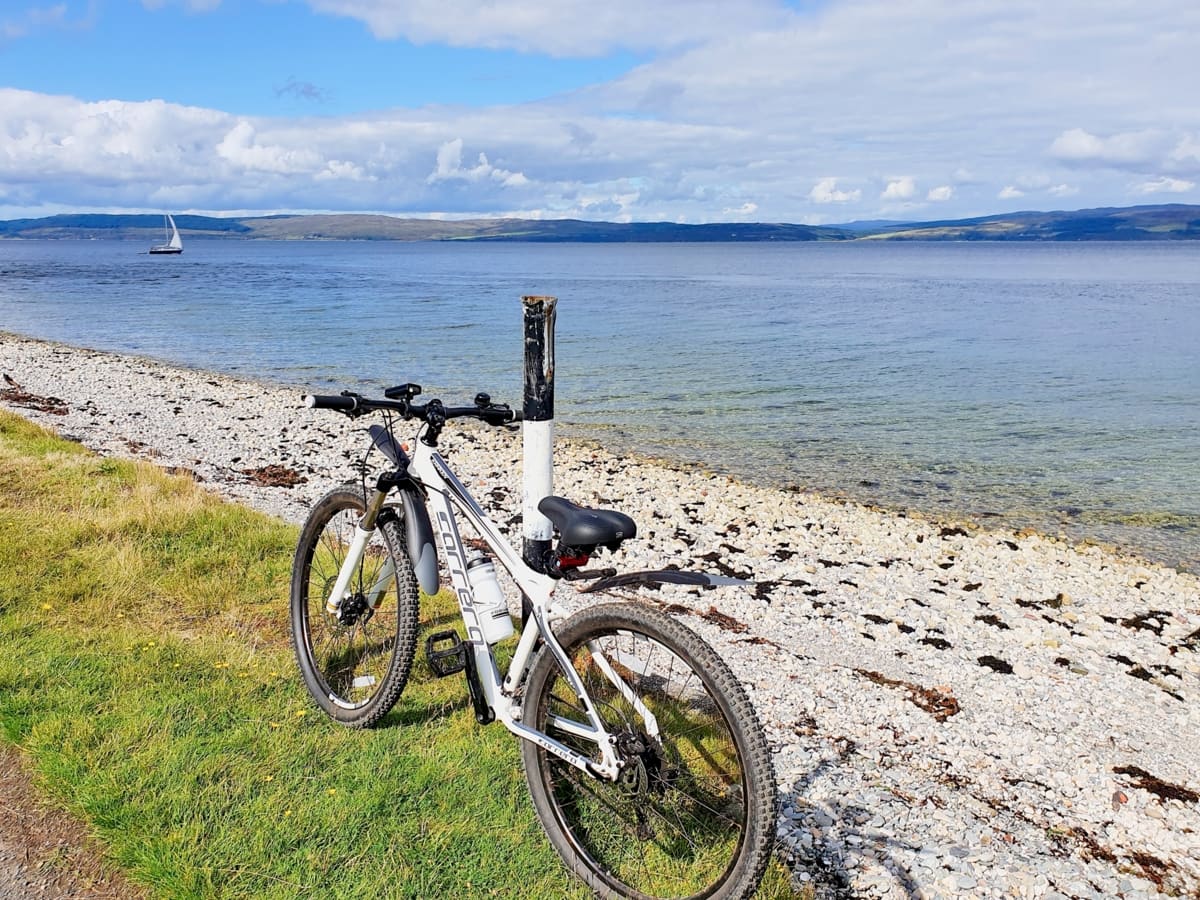
Five Ferries cycle route. Brodick-Lochranza, 14 miles. Claonaig-Tarbert, 10 miles. Portavadie-Colintraive, 19 miles. Rhubodach-Rothesay, 8 miles. Wemyss Bay-Ardrossan, 18 miles.
The CalMac Five Ferries cycling route is a popular and scenic adventure that takes cyclists on a journey through the most beautiful landscapes of the Scottish west coast. This unique route combines five ferry crossings (hence the name) and combines cycling on the mainland along with several islands, covering a total distance of approximately 69 miles (111 kilometres).
The journey begins at Ardrossan on the mainland where you’ll take the first ferry to the Isle of Arran. Once on Arran, you can explore the island’s picturesque villages and coastline (see my guide to the Arran Coastal Way), before hopping on the next ferry that takes you from Lochranza on Arran to Claonaig on the Kintyre Peninsula.
On the Kintyre Peninsula, you’ll cycle along quiet roads to the third ferry that takes you from Tarbert to Portavadie on the Cowal Peninsula where you’ll continue cycling through unspoiled countryside next to the Kyles of Bute and Loch Ruel.
The fourth ferry journey is from Colintraive to Rhubodach on the Isle of Bute. The Isle of Bute features a range of attractions including sandy beaches and lush woodlands so cyclists might like to book an extra night to explore the entire island.
The final ferry takes you from Rothesay on Bute back to Wemyss Bay on the mainland where you can then cycle the A78 back to the starting point at Ardrossan. The route is suitable for both experienced and novice cyclists, but as it has a mix of flat and hilly terrain, it’s recommended to complete it over at least two to three days to fully enjoy the sights along the way.
Book Tours in Scotland
Travel Around Scotland by Walking
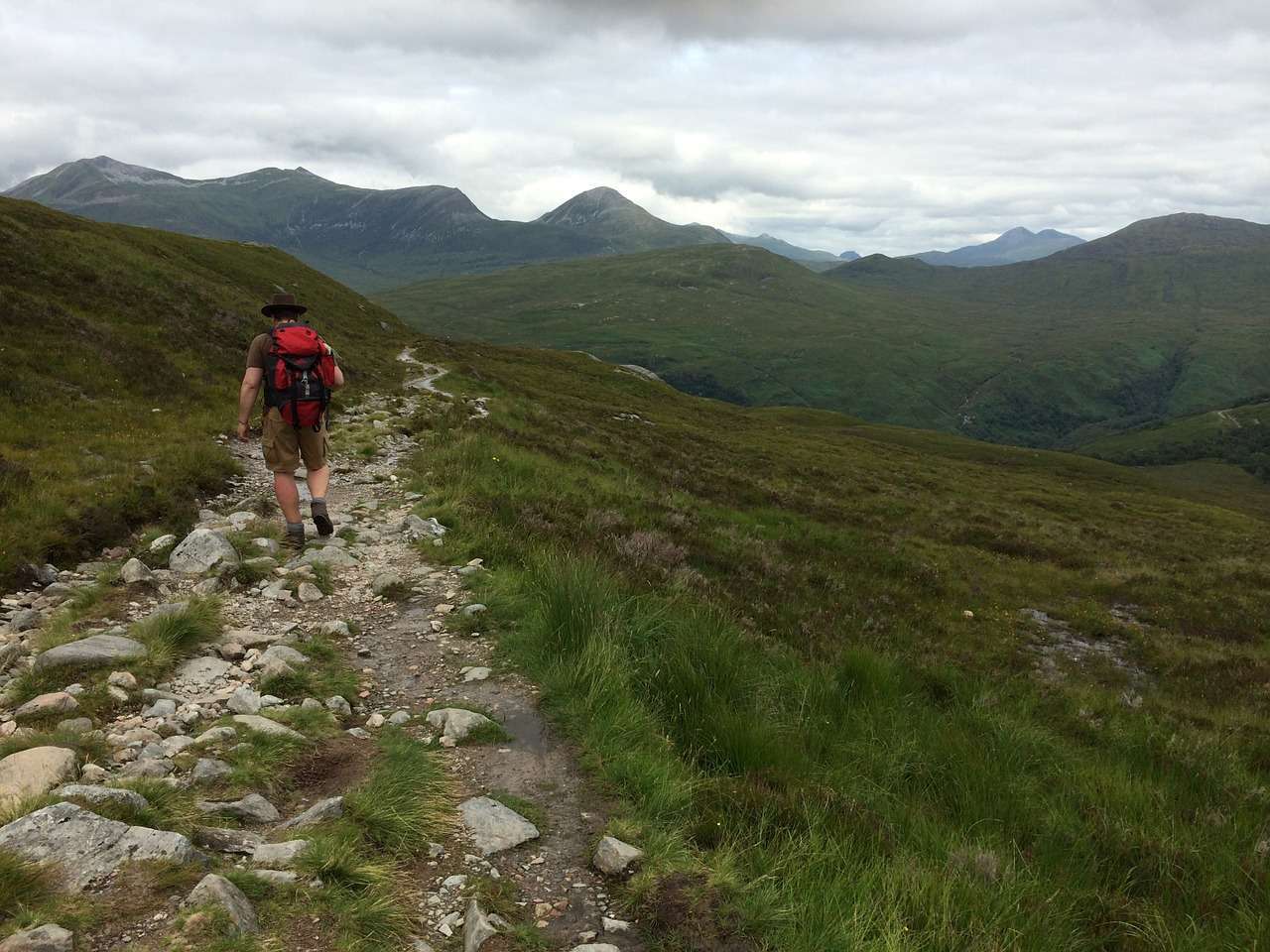
This last method of travelling around Scotland without a car is possibly the hardest but it’s also the cheapest – using your own two feet. Hiking in Scotland is a popular activity thanks to superb walking trails like the John Muir Way and the West Highland Way that are largely off-road and almost entirely free of traffic.
These trails allow you to explore the length and breadth of the country from the coastline to the mountains at your leisure, and due to the fact each has its own website you can easily plan whether to combine the trails, just do one short section, or embark on an epic hike across hundreds of miles.
Many of these walking routes follow the same pathways that cyclists follow but there are a few that are only accessible on foot like the ones that run off-track through Scotland’s mountains and remote Highland areas. Before you set out on a long-distance hike you need to take a few simple precautions which aren’t too much of a necessity in the Lowlands but are vital if you’re thinking of trekking at higher altitudes.
1: Prepare for bad weather even if it’s the middle of summer. The number of tourists that get lost in the Highlands is astonishing, and the Scottish Mountain Rescue Service is constantly called out to retrieve unprepared walkers who decided it was a good idea to hike Ben Nevis in flip-flops or camp overnight in a T-shirt.
2: Following on from the above, if you’re setting off on a hike into the wilds – even if it’s the middle of summer – make sure you’ve got a spare set of dry clothes as the wind chill on wet clothing can easily cause hypothermia. I never go hiking without my trusty waterproof backpack (Amazon link) which has never let water inside even during the most ferocious downpours (see my recommended backpacks).
3: Never, ever set off without a map. It’s very easy to get lost in the Highlands, and because the area is so vast you’ll often find you’re the only person for miles around. You can download maps onto your phone but bear in mind batteries don’t last forever so you’ll need to take a power pack with you. This one (Amazon link) is tiny, weighs almost nothing and easily fits into my backpack side pocket. As a backup, I recommend you get a paper OS map. Buy OS Explorer Maps direct from Ordnance Survey.
4: If you’re visiting from overseas you should know that throughout Scotland’s wilderness are a collection of shacks, huts and wee buildings known as ‘bothies’. A bothy is a place where you can take refuge from the elements if you find yourself in the middle of nowhere with no camping equipment, and they’ve saved countless lives over the years. The best resource to learn about them is The Scottish Bothy Bible by Geoff Allan.
Best Walking Trails in Scotland
Now let’s take a look at a selection of the best walking trails in Scotland.
The John Muir Way. This trail stretches 134 miles across Scotland’s heartland from Helensburgh on the west coast to Dunbar on the east, and I’m including it first because it’s my absolute favourite walking route in Scotland (admittedly I’m biased because I live on part of it).
The John Muir Trail is dedicated to the founder of America’s great national parks including Yosemite Valley and Sequoia National Park. John Muir lived most of his life in the U.S. but he was born in the East Lothian town of Dunbar.
Crossing vast stretches of pristine countryside, tranquil lochs, peaceful woodland, and glorious coastline, the John Muir Way allows visitors to see all the best bits of Scotland in a relatively compact area. Unlike the trails that meander through the Highlands, this walk takes you close to the cities of Glasgow and Edinburgh so you can quite easily spend a little time exploring the best urban attractions before getting back on the trail.
You can choose to do the separate sections that are detailed on the John Muir Way website or do what many hikers prefer and complete the entire route in one go. Expect to take 9-11 days to walk all of it.
The West Highland Way. This route celebrated its 40th birthday in 2020 so there’s a big push to advertise it to tourists – not that it needs much advertising as it’s arguably the most popular walking trail in Scotland.
Stretching 96 miles from Milngavie to Fort William, it passes through some of the most beautiful parts of the Highlands including Loch Lomond, Glen Etive, and Ben Nevis. It’s an absolutely jaw-dropping journey at every step of the way and has to be attempted if you’ve got any interest in exploring the landscapes of Scotland’s west coast.
It’ll take around 7 days to complete the entire route depending on your level of fitness, but as it’s so far off the beaten track you’ll need to arrange some form of overnight accommodation, whether that’s a tent or pre-booked B&Bs. Just be aware that as the trail is so busy in summer it’s almost impossible to find a vacancy unless you pre-book several weeks in advance.
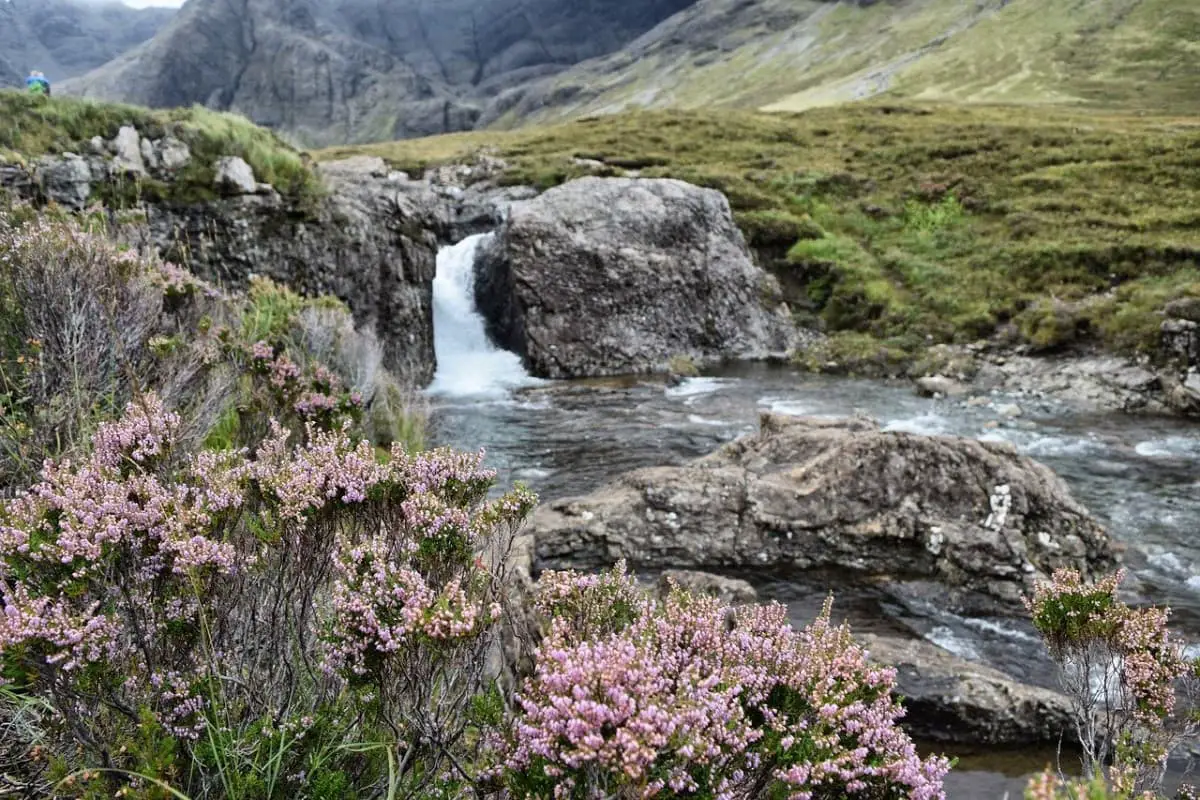
The Southern Upland Way. This is another coast-to-coast route in southern Scotland but it’s very different to the John Muir Way as it doesn’t get close to any built-up areas and instead lets you concentrate on exploring the countryside of the Lowlands in all its glory.
It’s a long trail at 214 miles so completing it in its entirety is best left to seasoned walkers, but it can be broken down into smaller sections and returned to at a later date which is what the majority of hikers tend to do.
Starting in Portpatrick on the southwest coast, you pass through much gentler and easier-going landscapes than you’ll find on the West Highland Way, though some hill sections rise to more than 2,000 feet. However, it’s not the elevation that catches out unwary walkers it’s the duration, with stretches like the 25 miles between St. Johns Town of Dalry and Sanquar being very hard on the feet.
It’s for this reason I suggest you break the walk into two sections with the first from Cockburnspath to Moffat taking a week and the second section from Moffat to Portpatrick taking another week.
The Great Glen Way. My last recommendation is the Great Glen Way which starts in the Highlands gateway town of Fort William and finishes in the Highland capital of Inverness – two towns that are worth visiting whether you intend to complete the entire route or not.
The Great Glen is the longest glen in Scotland (a glen is a valley) and it more-or-less follows the line of the Great Glen Fault. This walking trail is one of the most northern, so it’s a little less used than the others and some sections make you feel like you’ve gone off-grid, especially once you get past the village of Drumnadrochit.
Even though it’s a remote trail I have to say the sections I’ve walked are very easy as a lot of the paths are either forest tracks, canal towpaths, or purpose-built paths – but that’s not to say it’s all easy-going and you’ll find some sections ascend to nearly 1,400 feet.
The highlight of this 77-mile walk is Loch Ness which is even prettier in real life than the tourist guidebooks would have you believe. My advice is to take a slight detour off the trail once you get near Drumnadrochit and go visit Urquhart Castle which is an impossibly picturesque ruined castle with amazing views over the loch and a first-rate visitor centre.
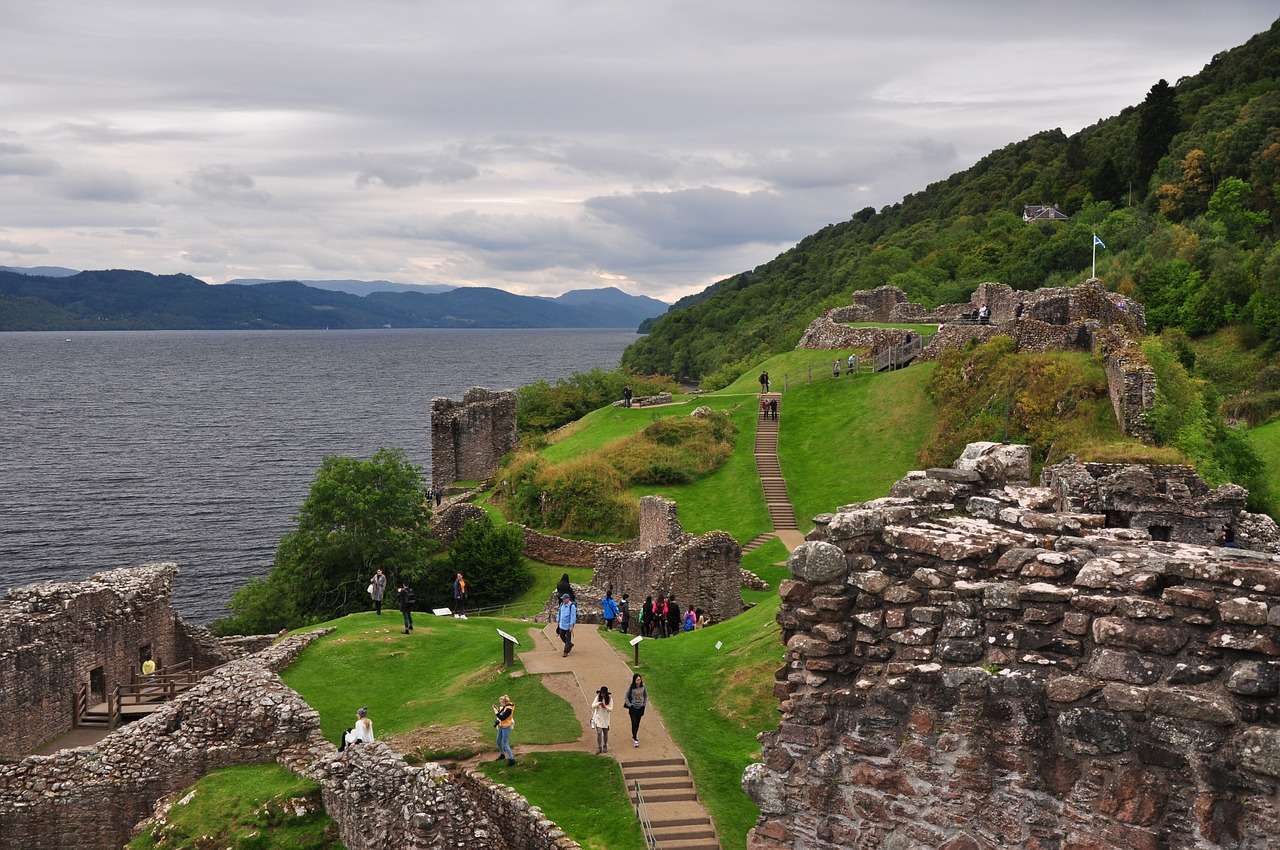
Protect Your Family From Scotland's Biting Midges
- Powerful, reliable protection for up to 8 hours
- Water- and sweat resistant
- Repels midges, mosquitoes, horse flies, sand flies, fleas and ticks
- Safe for use on adults, children over 30 months and pregnant women
- Non-sticky, moisturising with a pleasant fragrance
- Packaging may vary
Resources
Resources for Air Travel:
- Skyscanner – The premier internet flight booking website.
- Loganair – Scotland’s main airline for travelling to remote airports.
- Flightstats – Flight tracking website.
Resources for Train Travel:
- ScotRail – Scotland’s rail network. Pre-book tickets and passes directly from their website.
- Caledonian Sleeper – Luxury overnight train service between London and Scotland.
- Traffic Scotland – Mainly car travel information but also has links to rail information pages.
- West Coast Railways – Operators of the Jacobite Express.
Resources for Bus and Coach Travel:
- Rabbies Coach Tours – Recommended small group coach tours.
- Citylink – Coach travel company.
- Megabus – Coach travel company.
- First Bus – Bus operator throughout Scotland.
- Lothian Buses – Edinburgh bus operator.
- City Sightseeing – Open-top tour bus operator.
Resources for Cycling:
- Sustrans Cycle Network – Charity that maintains Scotland’s cycle trail network.
- Komoot – Cycle travel planning app.
- Forest and Land – Official forestry website with details of forest cycle paths.
Resources for Walking:
- UK Campsite – Lists campsites in Scotland and the rest of the UK.
- Walk Highlands – the best resource for finding walking routes in Scotland.
- Scotland’s Great Trails – Details all of Scotland’s walks in one website.
- Google Maps – Still the best digital mapping service.
- Ordnance Survey Maps – The best paper maps. These are a necessity.
Frequently Asked Questions
Where are the airports in Scotland?
Aberdeen, Barra, Benbecula, Campbeltown, Dundee, Edinburgh, Fair Isle, Glasgow, Inverness, Islay, Orkney, Shetland, Stornoway, Tiree, Wick.
How much does it cost to travel by train in Scotland?
As of 2022, it costs around £45 for a single journey from Edinburgh to Inverness and the same to travel from Glasgow to Aberdeen with a Scotrail standard ticket. Prices can double by upgrading to a first-class ticket.
Which are the best train lines to tour Scotland?
The West Highland Line – Glasgow to Mallaig. The Far North Line – Inverness to Wick. The Kyle Line – Inverness to Kyle of Lochalsh. The Carlisle Line – Carlisle to Glasgow. The Borders Line – Tweedbank to Edinburgh. The Stranraer Line – Stranraer to Glasgow.
How long do bus journeys take in Scotland?
Examples from Edinburgh: Aberdeen – 3 hours, Aviemore – 3 hours 30 minutes, Fort William – 4 hours 30 minutes, Inverness – 4 hours, Perth 1 hour 30 minutes, Pitlochry – 2 hours 20 minutes, Stirling – 1 hour 30 minutes.
Is it possible to go island hopping in Scotland without a car?
Yes, it is possible to go island hopping in Scotland without a car. Many of the islands in Scotland are connected by ferries and it’s possible to book tickets as a foot passenger with or without a bike for a fraction of the cost of taking a car.
The main ferry operator in Scotland is Caledonian MacBrayne (Calmac) which lists details of timetables and ticket prices on its website.
The Outer Hebrides is the best option for a car-free tour but I’d advise against an Isle of Skye tour on foot as many of the roads have fast-moving traffic.




